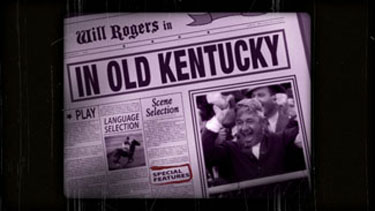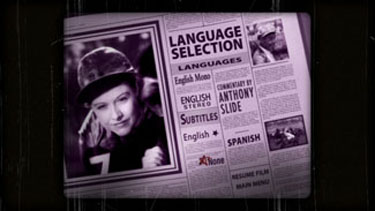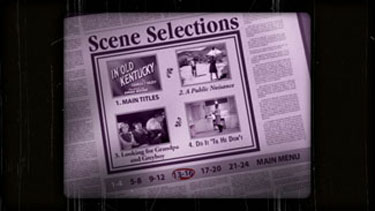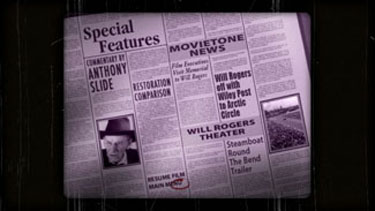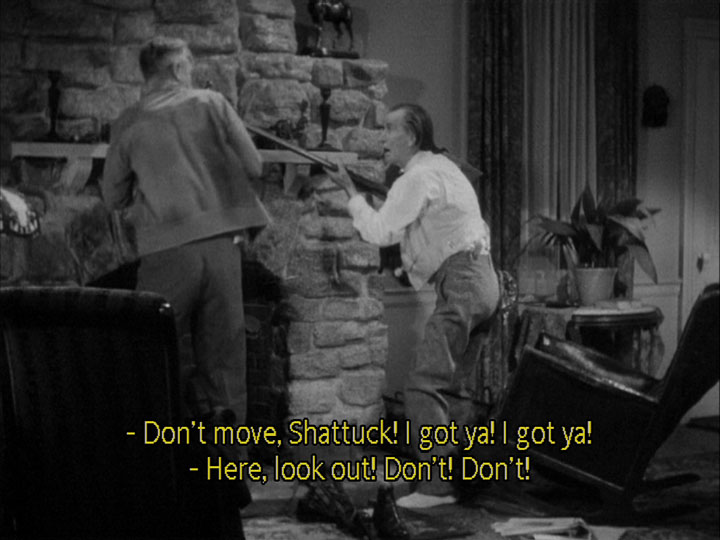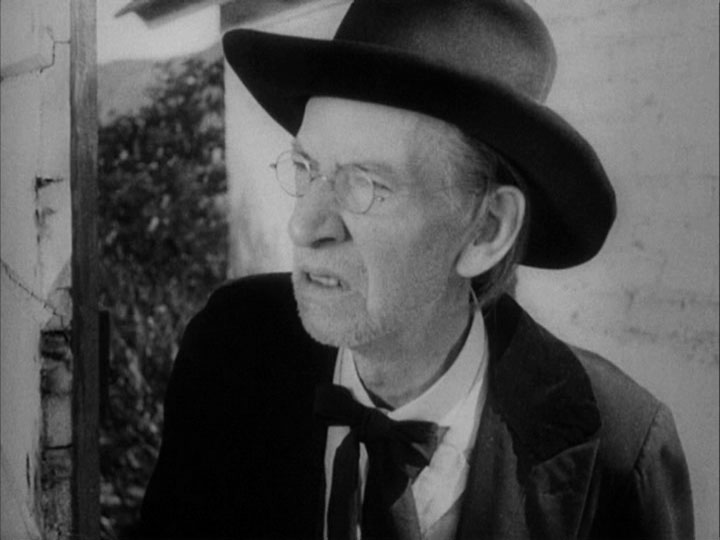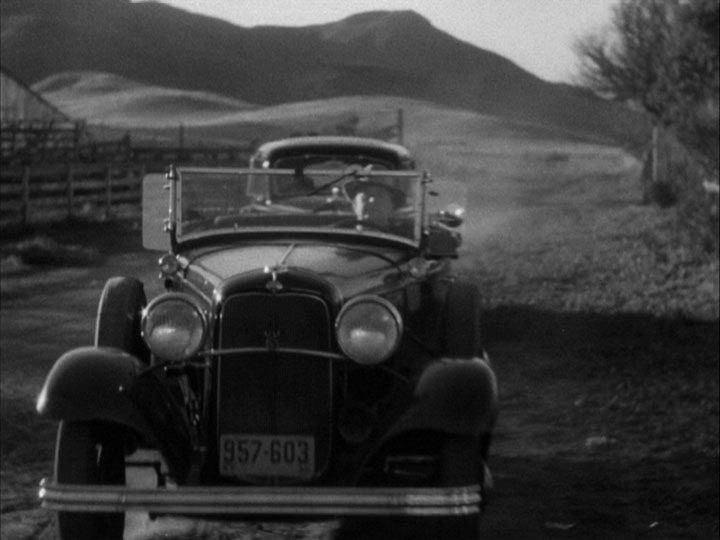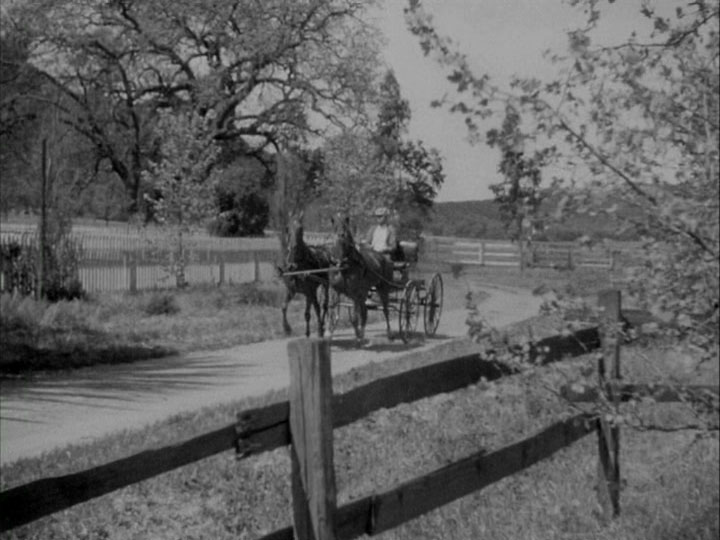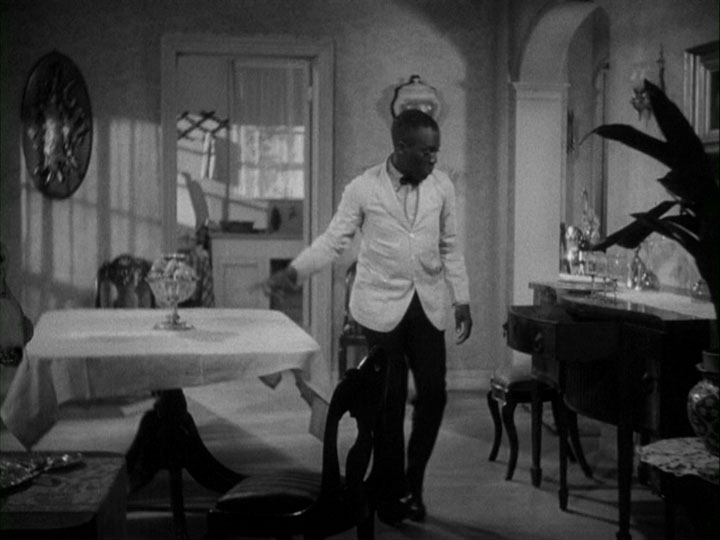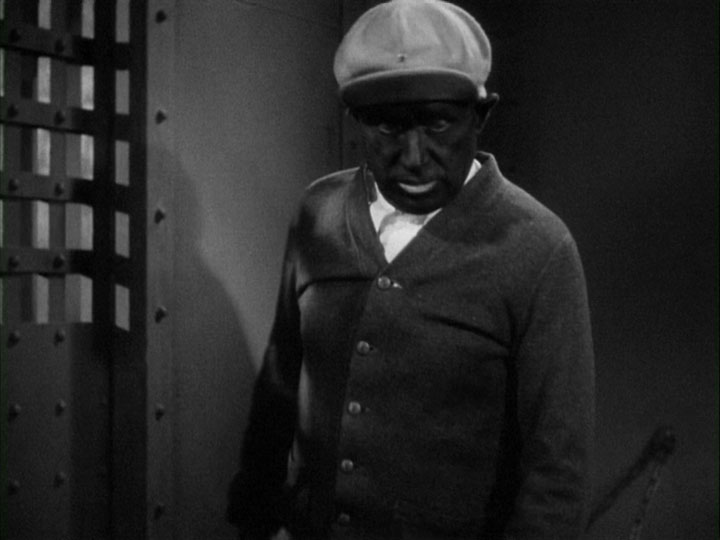![]()
![]()

![]()
![]()
 |
Will Rogers Collection, Vol. 1
In Old Kentucky
Steamboat Round the Bend
Doubting Thomas
Life Begins at
Forty
It’s a shame that my generation’s appreciation for Will Rogers has been lost
amidst the Tom Cruises, the Brad Pitts, and the Reese Witherspoons. To be
honest, fewer and fewer stars of the 1930s are remembered as fondly as they
should be and have regretfully become little more to present society than
names in the pages of history. For a film geek such as me, it can be
frustrating to realize that recognition isn’t going where recognition is
most-deserved. Yet, at the same time, the thought of exposing someone new to
the work of an actor such as Will Rogers is an exciting and promising
prospect.
Will Rogers was many things to many people: a gifted humorist, newspaper
columnist, radio personality, and most notably (from his perspective), a
cowboy at heart. It took some time for Rogers to discover his knack for
comedy, but once he did, his humble personality and grounded philosophies
won him a legion of fans. Fox (before merging with Twentieth Century)
promptly signed Rogers to one of the most illustrious contracts of his
time--one offering the actor $15,000 a week. Neither money nor fame changed
the actor’s lifestyle (he would still travel consistently while working his
film schedule around his trips) or values.
While Rogers’ certainly conveyed enough wit to sustain an audience for
hours, it was his acting technique that separated him from other comedians
of his time. Rogers, like a handful of other early comedic actors, would
often improvise and use the script only as a guideline for the general
direction of the film. Although his co-stars would occasionally struggle
with the changes and inadvertently miss their cues, improvisation elevated
many actors’ performances, particularly in comedies, largely because of the
freedom to experiment with already humorous dialogue and clever situations
(just compare the number of laughs Robin Williams generates during his live
shows as opposed to his more controlled performances in film). It was also
commonly believed that improvisation would enhance the realism of film and
give the impression of “natural” dialogue. Thus, Rogers preferred to keep
rehearsing to a minimum.
Rogers’ line deliveries were also an important part of his talent. He often
emphasized specific mannerisms in order to specific personality traits. His
characters rarely had anything substantial to say, but Rogers never failed
to embody them with Southern charm and folksy ideals. While it’s apparent
why Rogers never won any awards for his acting, there is satisfaction in
knowing that he created a timeless quality in his characters, which is why
he has continued to appeal to audiences for more than seventy years.
Although Fox has packed their Volume 1 Collection of Will Rogers films with
his more modest body of work, Fox deserves credit for taking the initiative
to finally release several of the iconic actor’s films on DVD. This
collection comes with a high recommendation for fans of classic cinema.
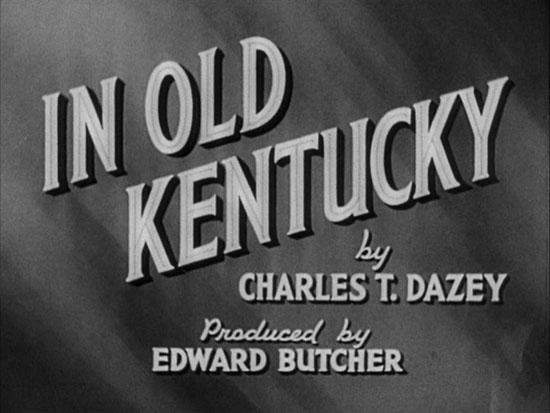
directed by George Marshall
USA 1935
As entertaining as it is to see the
legendary Bill "Bojangles" Robinson teaching Will Rogers how to dance in
1935’s “In Old Kentucky,” the film suffers from carelessly racist overtones
and an often overly formulaic plotline. In retrospect, it’s hardly
surprising that director George Marshall was at the helm of such a project.
Marshall had recently finished directing Will Rogers in “Life Begins at 40”
(1940), and his new project excited the celebrated actor since it offered
Rogers a chance to play a character that shared his native background
(Rogers was born in Oklahoma). Marshall worked with a script (derived from
Charles T. Dazey’s play) that was awfully similar to his previous film, and
in light of the success of “Life Begins at 40,” it’s easy to see why. Rogers
once again stars as man rebelling against the pressures of the rich and
powerful, causing them as many problems as he can muster. Somehow, Rogers’
still has time to rouse young love just as he did in “Life Begins at 40.”
However, Dazey’s play takes advantage of the Kentucky setting by employing a
traditional Oklahoman theme of a deep-rooted, long-lived feud between two
families. Of course, Will Roger’s character, Steve Tapley, finds himself in
the middle of the feud, having been fired by his boss, Pole Shattuck
(Charles Richman), for socializing with the enemy, The Martingales. Old Man
Martingale (Charles Sellon) offers Tapley an opportunity to work on his
ranch and attempt to settle the score with his former boss by defeating him
in a horse race.
The racial issues come into play towards the end of the film when Tapley
colors his skin black and attempts to pass himself off as the house servant,
Wash Jackson (Bill Robinson). The sight of Rogers’ attempting to replicate
the enthused dancing of Robinson is quite funny, yet the racial stereotypes
recall numerous politically incorrect films, particularly D.W. Griffith’s
“The Birth of a Nation” (1915). It’s unfair to dismiss “In Old Kentucky”
entirely on the basis of its racism, but the aforementioned scenes are
certain to upset a large portion of today’s audiences.
Posters
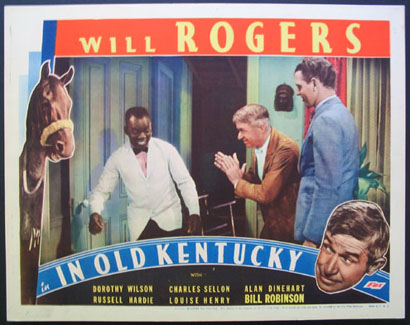 |
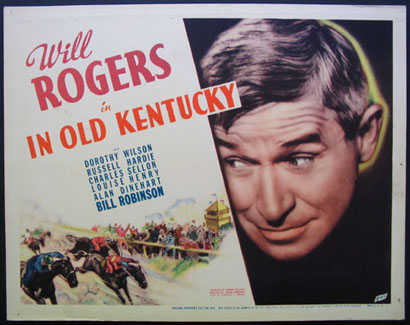 |
Theatrical Release: November 28th, 1935
Reviews More Reviews DVD Reviews
DVD Review: 20th Century Fox - Region 1 - NTSC
Big thanks to Kurtis J. Beard for the Review!
| DVD Box Cover |
|
CLICK to order from: |
| Distribution |
20th Century Fox Region 1 - NTSC |
|
| Runtime | 1:25:53 | |
| Video |
1.33:1 Original Aspect Ratio |
|
|
NOTE: The Vertical axis represents the bits transferred per second. The Horizontal is the time in minutes. |
||
| Bitrate |
|
|
| Audio | English (Dolby Digital 2.0), English (Dolby Digital 1.0) | |
| Subtitles | English, Spanish | |
| Features |
Release Information: Studio: 20th Century Fox Aspect Ratio:
Edition Details: Chapters 24 |
|
| Comments |
Video: “In Old Kentucky” is presented in its original aspect ratio of 1.33:1. The image is relatively clean and often quite crisp--a prime testament to Fox’s restoration process. Scratches and surface flecks can be seen occasionally, but contrast levels are appropriate. Audio: The audio is presented in a Dolby Digital 2.0 track, which suits the southern sounds of Oklahoma quite well. Unfortunately, there’s considerable distortion when the audio reaches higher frequencies. Still, for a film from the 1930s, the track is certainly passable. A Dolby Digital 1.0 track is also included. Extras: Fox has provided a restoration comparison between the source print and the transfer provided on the DVD. A total of 50 hours were spent on the restoration of “In Old Kentucky.” Anthony Slide’s third audio commentary track in the Will Rogers set is particularly disappointing. Sure, Slide enlightens us with his keen observations, but he also dismisses the film quite hastily and conveys an obvious distaste for the film. At the very least, a negative commentary is a change of pace. Lastly, two movietone reels are included. The first has film executives visiting a hospital (funded by Will Rogers) that offers assistance to entertainers. The second outlines the cause of Rogers’ tragic and unexpected death. |
DVD Menus
|
|
|
|
|
|
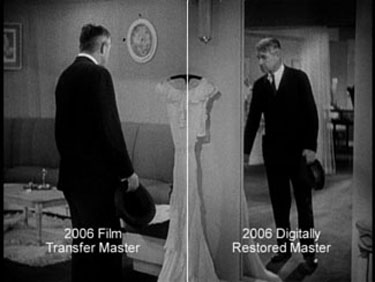 |
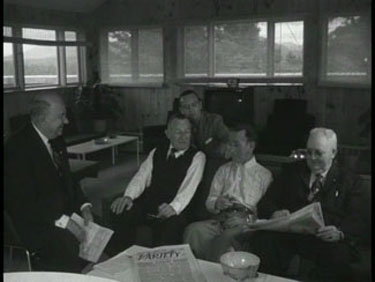 |
Screen Captures
Subtitle sample
|
|
|
|
|
|
|
|
|
|
|
|

(aka "Steamboat Bill" )
directed by John Ford
USA 1935
John Ford is best remembered as the director who brought us “The Informer”
(1935), “The Grapes of Wrath” (1940), “The Searchers” (1956), and “The Man
who Shot Liberty Valance” (1962). Will Rogers is warmly remembered as the
kind-hearted comedic actor who became America’s favorite star during the
early 1930s. You’d think the two would be a very unlikely pairing in
Hollywood, but their friendship and mutual respect culminated in three
spirited motion pictures--“Doctor Bull” (1933), “Judge Priest” (1934), and
“Steamboat ‘Round the Bend” (1935). Although the least of the three is
included in the set, the film still has its share of humor and Rogers’
genial screen persona.
“Steamboat ‘Round the Bend” was a personal project for Ford who saw the
novel (Ford purchased the adaptation rights from writer Ben Lucien Burman)
as a potential opportunity to work with his good friend Will Rogers. The
pictures he directed at Fox were usually lighter affairs with a sustained
focus on entertainment rather than art. Ford is generally not remembered for
such films because his precise framing and noble themes brought him far more
recognition and acclaim. Nevertheless, Ford still had the sense to know how
to present a good comedy.
In the film, Will Rogers plays Dr. John Pearly, a traveling salesman who has
finally saved enough money to begin his lifelong dream--to be a steamboat
pilot. Pearly and his nephew, Duke (John McGuire), purchase a steamboat that
is clearly in need of repair, but the two are hardly fazed by a little elbow
grease. Tragedy strikes when Duke murders a man in defense of his
girlfriend, Fleety Belle (Anne Shirley). Pearly hardly takes a liking to the
girl, particularly because she’s caused his nephew potential trouble with
the law. Pearly advises Duke to plead self-defense after reasoning that no
judge in his right mind would ever conclude that the man’s unfortunate death
was intentional. Unfortunately, the judge sentences Duke to the death
penalty by means of hanging, and Pearly must find a way to save his nephew’s
life. Pearly and Fleety Belle embark on a quest up the Mississippi in order
to find a potential witness who ends up being a half-crazed religious man.
Along the way, they just happen to fall into a steamboat race, which
concludes in a thrilling and often hilarious finale.
“Steamboat ‘Round the Bend” is clearly a minor effort in John Ford’s oeuvre.
The supporting performances are mostly uninspired, with the notable
exception of Anne Shirley, Francis Ford (John Ford’s older brother, who
plays a genuinely hilarious drunk), and the always-entertaining Will Rogers.
This is, after all, a Will Rogers film and that’s precisely who audiences
were paying to see.
Poster
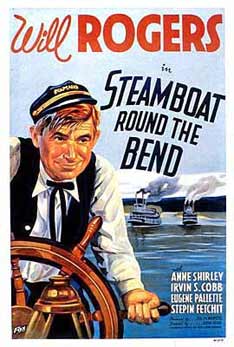 |
Theatrical Release: September 6, 1935
Reviews More Reviews DVD Reviews
DVD Review: 20th Century Fox - Region 1 - NTSC
Big thanks to Kurtis J. Beard for the Review!
| DVD Box Cover |
|
CLICK to order from: |
| Distribution |
20th Century Fox Region 1 - NTSC |
|
| Runtime | 1:21:12 | |
| Video |
1.33:1 Original Aspect Ratio |
|
|
NOTE: The Vertical axis represents the bits transferred per second. The Horizontal is the time in minutes. |
||
| Bitrate |
|
|
| Audio | English (Dolby Digital 2.0), English (Dolby Digital 1.0) | |
| Subtitles | English, Spanish | |
| Features |
Release Information: Studio: 20th Century Fox Aspect Ratio:
Edition Details: Chapters 20 |
|
| Comments |
Video: Available in its original aspect ratio of 1.33:1, “Steamboat ‘Round the Bend” suffers from minor damage; however, given the age of the film print, occasional flecks and blemishes are to be expected. Fox has clearly done their best to remove all noticeable scratches, which has resulted in a much cleaner transfer. Exterior shots show the worst signs of aging and occasionally suffer from awfully mis-balanced contrast levels, particularly during night-time sequences. Audio: Again, given the age of this film, audio is certainly weaker than one would hope. Over the entirety of the Dolby Digital 2.0 track, there is very little range, and the audio levels certainly peak much higher than they should, particularly when the locals are hooting and hollering. A Dolby Digital 1.0 track is also included. Extras: Fox has provided a restoration comparison between the source print and the transfer provided on the DVD. Obviously, there are considerable differences, and clearly Fox has repaired a good portion of the damage and restored the contrast to appropriate levels. A short clip from each film included in the Will Rogers Collection is compared. Fox also includes the amount of time that was spent on repairing each print. A total of 65 hours were spent on the restoration of “Steamboat ‘Round the Bend.” A commentary by John-Ford-biographer Scott Eyman is also provided. Eyman offers a wealth of knowledge on both Ford and Rogers while casually offering occasional anecdotes that provide fascinating insights into the lives, relationships, and filmmaking/acting techniques of both men. Eyman speaks fluidly and briskly with very few silent breaks. It’s a pleasure to listen to him speak. A worn trailer is also provided on the DVD, and it clearly indicates, on numerous occasions, that the film is a Will Rogers vehicle. |
DVD Menus
|
|
|
|
|
|
 |
 |
Screen Captures
Subtitle sample
|
|
|
|
|
|
|
|
|
|
|
|

directed by David Butler
USA 1935
It’s hardly surprising that Will Rogers was unable to rise above the many
clichés that exist in the awfully familiar plot of “Doubting Thomas” (1935).
It’s a shame because the film obviously had potential with the strong
performances from its leads, particularly with Billie Burke (the “Good
Witch” from “The Wizard of Oz,” 1939) playing Rogers’ wife. Nevertheless,
we’re still treated to one fine sequence that has plenty of laughs--the
showing of a local play gone awry. I just hope you’ll be able to turn off
your brain for the remainder of the film.
“Doubting Thomas” concerns Thomas Brown (Will Rogers), who’s a firm believer
in traditional attitudes--especially when it comes to the woman’s role in a
marriage. Thomas expects his wife to stay home, clean the house, and cook
the meals. His wife, Paula (Billie Burke), has other plans when she’s given
a leading role in a local play. Thomas pleads with her to reconsider but
eventually gives up after recognizing her persistence in the matter. When
the play is finally exhibited after some preparation, all goes wrong--actors
miss their cues, sound effects are ill-timed, and props pose numerous
problems. In light of the situation, the audience interprets the play as a
comedy, but Thomas feels the show is a failure. After the positive
reception, he’s forced to develop a new plan of action as his wife becomes
more enthralled by the thought of acting full-time. He devises an
arrangement that will see a director cast him over his wife after a series
of screen tests. The threat of Thomas leaving to Hollywood saddens Paula
greatly and eventually a compromise is achieved--no more acting!
The weaknesses in David Butler’s direction are reasons to fault this film’s
inability to put a new spin on a dated story. Will Rogers’ charm can only be
stretched so far without any visual flair or gripping themes. “Doubting
Thomas” is good for a few laughs on a rainy day or a Sunday afternoon, but
it is still best-appreciated by die-hard Will Rogers fans.
Theatrical Release: July 10, 1935
Reviews More Reviews DVD Reviews
DVD Review: 20th Century Fox - Region 1 - NTSC
Big thanks to Kurtis Beard for the Review!
| DVD Box Cover |
|
CLICK to order from: |
| Distribution |
20th Century Fox Region 1 - NTSC |
|
| Runtime | 1:14:27 | |
| Video |
1.33:1 Original Aspect Ratio |
|
|
NOTE: The Vertical axis represents the bits transferred per second. The Horizontal is the time in minutes. |
||
| Bitrate |
|
|
| Audio | English (Dolby Digital 2.0), English (Dolby Digital 1.0) | |
| Subtitles | English, Spanish | |
| Features |
Release Information: Studio: 20th Century Fox Aspect Ratio:
Edition Details: Chapters 16 |
|
| Comments |
Video: Presented in the film’s original aspect ratio of 1.33:1, the transfer has significant surface damage and considerable grain. Scratches are most common along the right side and of particular note during the opening titles. Nevertheless, the image is decent for its age; certain areas may not be as crisp as one would hope, but the transfer is marginally passable. Again, exterior night-time shots suffer from the most damage and contrast issues. Audio: The Dolby Digital 2.0 track is suitable for this dialogue-driven film. There are intermittent moments of distortion, but taking into consideration the film’s lack of action, the track rarely has to exert a wide range of frequencies. A Dolby Digital 1.0 track is also included. Extras: Fox has provided a restoration comparison between the source print and the transfer provided on the DVD. A total of 110 hours were spent on the restoration of “Doubting Thomas.” Anthony Slide offers his thoughts and opinions on the work of Will Rogers in a rather bland audio commentary track. Slide reiterates many of the same points he made in other commentaries from the Will Rogers Collection and again, with this track, there are several long pauses. Nevertheless, Slide clearly respects the film and offers fascinating information about the impact that Rogers’ death had on the general public. Apparently, Rogers was a universally-respected man. Also included is A&E’s excellent biography of Will Rogers. A wealth of insights is provided on everything from his birth and upbringing to his untimely death. Most-interesting is the footage of Rogers’ expansive silent work and archival footage of the comedian cracking jokes. Retrospective interviews provide additional anecdotes that give viewers a “complete picture” of the iconic actor, and we also get a chance to see a few familiar faces. Two movietone reels are also included. The first clip has Fox’s Shirley Temple presenting a plaque for a soundstage dedicated to Will Rogers. The second is a promotional piece encouraging support for Will Rogers’ charity. |
DVD Menus
|
|
|
|
|
|
 |
 |
Screen Captures
Subtitle sample
|
|
|
|
|
|
|
|
|
|
|
|

(aka "Life Begins at Forty" )
directed by George Marshall
USA 1935
“Life Begins at 40” (1935) is perhaps one of my favorite
Will Rogers films because it’s immediately evident that Rogers takes pride
in developing a character that shares his ideals and motivations as well as
one of his occupations. He stars as Kennesaw Clark, a newspaper editor with
a penchant for living life in the moment and a gift for spurting clever
political quips (sound familiar?). Clark’s positive outlook on life,
regardless of one’s age, is a fascinating subject to see in the 1930s,
particularly when the practice of age discrimination was extremely common in
Hollywood (as it still is today in some respects). The script for “Life
Begins at 40” is also surprisingly insightful and perceptive given the time
of its release. Clark remarks on several occasions that society’s reliance
on technology is absurd and notes that someday everything could just as
easily be reduced to the push of a button. Since the script tackles such
observant and alternately hilarious themes, I would hardly be surprised if
Kennesaw Clark was one of Rogers’ favorite characters.
“Life Begins at 40” is also one of Rogers’ least offensive films--one that
avoids racism entirely by replacing Stepin Fetchit with Sterling Calloway as
Rogers’ right hand man. Stepin Fetchit clearly weakened films (by no fault
of his own) such as “Judge Priest” (1934) and “Steamboat ‘Round the Bend”
(1935) as he was virtually reduced to a caricature who conveyed overtly
racist overtones. Sterling Calloway is an able replacement and one who is
infinitely more pleasant and fun to watch. Although Rogers has his share of
sexist remarks, the time period of this film must be taken into
consideration (of course, time is never an excuse for prejudiced attitudes).
The film concerns a young man (Richard Cromwell) who’s been wrongfully
convicted of theft and Clark’s attempt to restore the boy’s reputation in a
small town. Along the way, he must contend with the town’s bank manager and
key financier for his newspaper, Col. Joseph Abercrombie (George Barbier).
However, Clark still finds the time to act as a matchmaker for his
attractive neighbor and the young man he’s defending.
“Life Begins at 40” may pair Will Rogers with yet another relatively
unexceptional female lead (Rochelle Hudson), but the gifted Jane Darwell
(“The Grapes of Wrath,” 1940) is a strong female foil for Rogers. Slim
Summerville, whose physical comedy is well suited for this film, provides
another key supporting performance. Having two talented comedians complement
each other so effectively is a pleasure to watch. The film is ably, albeit
blandly, directed by George Marshall. Marshall is clearly a step down from
John Ford, but at least he knows how to handle a Will Rogers film.
Theatrical Release: March 22, 1935
Reviews More Reviews DVD Reviews
DVD Review: 20th Century Fox - Region 1 - NTSC
Big thanks to Kurtis J. Beard for the Review!
| DVD Box Cover |
|
CLICK to order from: |
| Distribution |
20th Century Fox Region 1 - NTSC |
|
| Runtime | 1:19:50 | |
| Video |
1.33:1 Original Aspect Ratio |
|
|
NOTE: The Vertical axis represents the bits transferred per second. The Horizontal is the time in minutes. |
||
| Bitrate |
|
|
| Audio | English (Dolby Digital 2.0), English (Dobly Digital 1.0) | |
| Subtitles | English, Spanish | |
| Features |
Release Information: Studio: 20th Century Fox Aspect Ratio:
Edition Details: Chapters 20 |
|
| Comments |
Video: The video is presented in the film’s original aspect ratio of 1.33:1. There are instances of surface scratches, flecks, and considerable grain. Long shots and medium shots appear somewhat soft compared to the crisp close-ups. There also appears to be several frames missing at various points in the film, which produces a skipping effect (a problem that is present throughout Fox’s Will Rogers Collection). However, mid-day exterior shots are well-lit and hold up much better than footage in some of the other Will Rogers films. Audio: Audio levels are seriously tested in this Dolby Digital 2.0 track, particularly during a ‘pig calling’ scene where there is evidence of some serious distortion. During such distortion, the audio is only unpleasant at excessive volumes. The audio also suffers from a low-pitched humming that can be found in many older films. A Dolby Digital 1.0 track is also included. Extras: Fox has provided a restoration comparison between the source print and the transfer provided on the DVD. A total of 90 hours were spent on the restoration of “Life Begins at 40.” Film historian Anthony Slide provides an audio commentary track that offers a variety of background information on Will Rogers as well as several personal anecdotes about the actor. I would have preferred more background on the film to Slide’s sporadic choice of gossip, but the commentary is still informative regardless of a number of silent gaps. After twenty minutes, it’s clear Slide would have benefited from playing off of another expert or possibly an interviewer. |
DVD Menus
|
|
|
|
|
|
 |
|
Screen Captures
Subtitle sample
|
|
|
|
|
|
|
|
|
|
|
|


